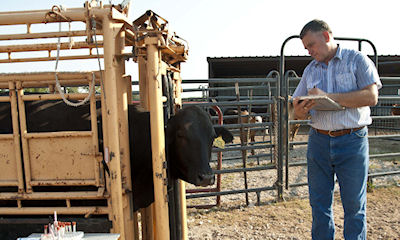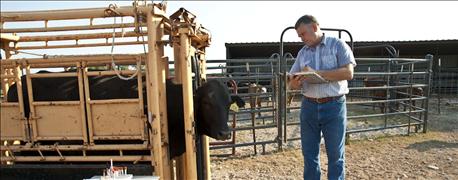November 29, 2015

Vaccines, a vital part of keeping all livestock healthy, help in the prevention of disease, which results in less utilization of antibiotics due to fewer sick animals.
Related: Consider long-term goals in fall cattle vaccination plan
According to South Dakota State University's Extension Dairy Field Specialist Tracey Erickson, livestock vaccines provide protective immunity approximately 21 days following the initial vaccination in the majority of animals. Some livestock vaccines may require a booster vaccination(s) to ensure immunity for the period designated by the manufacturer.

Use these tips for keeping animal vaccines viable and protecting herd health. USDA APHIS photo by R. Anson Eaglin.
There are multiple factors influencing immunity, including but not limited to, medical history, vaccine type, method of administration, age, and species being vaccinated, Erickson says. While a valid Vet-Client-Patient relationship will help you as you select the vaccine of choice for your livestock health program, Erickson offers these tips for understanding the types of livestock vaccines and how to keep and store animal vaccines.
Vaccine types
You are probably utilizing one of two types of livestock vaccines: inactivated ("killed") vaccines, which contain bacteria or viruses that have been inactivated by heat or chemicals, or modified-live virus vaccines, which contain whole viruses that have been altered in such a way that, while they are able to multiply within the body, their ability to cause disease has been taken away.
What causes livestock vaccines to lose effectiveness?
So how do vaccines become worthless? Proteins are the major components of the organisms that make up both killed and MLV vaccines. Proteins are denatured by the interaction of two major factors: time and temperature. In addition, most common disinfectants will render modified live organisms inactive. So the anti-bacterial soap or even city or rural water, which contains chlorine, can have an effect on vaccines, when residues are present in your syringes or transfer needles. Thus, rinse with distilled water which is near the boiling point.
Related: E. coli vaccine works, but is rarely used in feedlot cattle
Handling, storing and using animal vaccines
Other considerations for handling, storing and using vaccines are as follows:
Purchasing & use considerations of animal vaccines – check expiration dates and make sure you can use it before it expires. For MLV vaccines purchase smaller dose instead of larger dose vials, which will enable using the vaccine in a shorter time period. Also remember to purchase an adequate number of needles and plan on replacing the needle about every 5-10 head. Do not straighten a bent needle, replace it!
~~~PAGE_BREAK_HERE~~~
Transporting and storing vaccines – check the recommended storage temperature, and use a cooler while transporting and while vaccinating to keep the vaccine at the recommended temperature and also to minimize exposure to sunlight. Check your refrigerator's temperature periodically to assure that it is working properly and is keeping the vaccines at the correct temperature.
Equipment and work area – Make sure your equipment is clean and rinsed with distilled water to remove any residues. Set up an area for syringes such that they are kept cool, shaded, and dust-free while working.
While working with animal vaccines – Keep vaccines in a cooler with ice packs in summer or possibly hot packs in winter if it is too cold. (Check vaccine labels for proper storage temperature.) If using MLV vaccines, only rehydrate the vials either one at a time or as they are needed. Make sure you are using a clean transfer needle and use only the diluent supplied by the manufacturer to rehydrate the vaccine. Always use a brand-new needle to draw up the vaccine into the syringe. When using needle-free injection systems, or syringes that draw doses from a tube attached to the vaccine bottle, care should be taken to assure the bottle and tubing stay cool and shaded from sunlight.
Related: Make Vaccination One Step to Build Herd Health Program
Discard mixed or partial livestock vaccines – Discard any mixed MLV vaccines that are not used, as they are only viable for about an hour or two after reconstitution. Discard any partial bottles of inactivated vaccine that have been contaminated by dirty needles. Return unmixed MLV and unused inactivated vaccines to proper storage as soon as possible. Clean syringes, transfer needles, and tubing. Make sure to rinse with distilled, boiling water inside and out. Follow the manufacturer's directions on proper cleaning and maintenance of needle-free injection systems. Burn empty vaccine bottles or follow label directions for disposal of containers and needles.
"The success of any livestock vaccination program depends on the effectiveness of the vaccine used," Erickson adds. "Vaccines-which in essence are suspensions of biological organisms – will become ineffective if proper storage and handling recommendations are not followed."
Thus, if they are not followed you have in essence wasted a lot of money and time, she says, and have increased the potential for livestock illness and death loss due to disease that might have been avoided.
Source: SDSU
Planning for all possibilities is the best way to prepare for a successful calving season. But do it right! Download our free report, Best Practices for a Successful Calving Season, to ensure you have everything in place to limit stress on you and your herd.
You May Also Like




